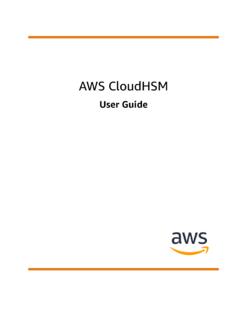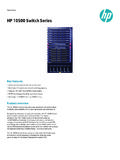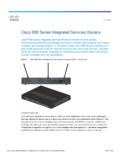Transcription of Alcatel-Lucent 7750 Service Router Series data sheet
1 Key features Flexible, scalable, and high performance: delivers high bandwidth, low latency User, content, and application intelligence: Service differentiation with non-stop routing and services Field proven OS: Feature-rich, fault-tolerant operating system for enterprise and cloud services Operational efficiency: common SR and optical portfolio management platform with Service -aware network management, operation, and reportingProduct overviewThe Alcatel-Lucent 7750 Service Router (SR) Series delivers the performance, Service richness, and intelligence to drive the converged IP network edge. Leveraging 400 Gbps FP3 network processing (NP) silicon technology, the portfolio scales capacity up to Tbps and delivers up to 36 x 100 GbE, 60 x 40 GbE, or 360 x 10 GbE ports.
2 With support for a comprehensive suite of Layer 2 and Layer 3 routing capabilities, advanced traffic management, hierarchical quality of Service (HQoS), and specialized Service -aware application processing, this feature-rich multiservice routing platform enables the full range of advanced business, residential, mobile services and dynamic applications without sacrificing performance. It integrates IPv4/IPv6, MPLS, Ethernet, Provider Backbone Bridge (PBB), and MPLS Transport Profile (MPLS-TP) protocols with a broad range of Ethernet and multiservice interfaces. The 7750 SR platform supports redundant system hardware and line card redundancy for high availability and resilience. The comprehensive feature set enables a best-of-breed multiservice edge Router that supports end-user, business, cloud, and data center interconnect services for HP s target large enterprise and cloud Service provider sheetAlcatel- lucent 7750 Service Router Series2 Features and benefitsQuality of Service (QoS) Hierarchical QoS (HQoS)Provides a built-in QoS engine that supports hierarchical QoS (HQoS) and can implement a hierarchical scheduling mechanism based on ports, user groups, users, and user services .
3 Also cooperates with MPLS Traffic Engineering (TE) to implement bandwidth reservation and scheduling based on tunnels and services Weighted random early detection (WRED)/random early detection (RED)Delivers congestion avoidance capabilities through the use of queue management algorithms Advanced classifier-based QoSClassifies traffic using multiple match criteria based on Layer 2, 3, and 4 information; applies QoS policies such as setting priority level and rate limit to selected traffic on a per-port or per-VLAN basis Bandwidth shaping Port-based rate limitingProvides per-port ingress-/egress-enforced increased bandwidth Classifier-based rate limitingUses an access control list (ACL) to enforce increased bandwidth for ingress traffic on each port Reduced bandwidthProvides per-port, per-queue egress-based reduced bandwidth Traffic policingSupports Committed Access Rate (CAR) and line rateVirtual private network (VPN) Layer 2 Tunneling Protocol (L2TP)An industry standard-based traffic encapsulation mechanism supported by many common operating systems.
4 Will tunnel the Point-to-Point Protocol (PPP) traffic over the IP and non-IP networks; may use the IP/UDP transport mechanism in IP networks Generic Routing Encapsulation (GRE)Transports Layer 2 connectivity over a Layer 3 path in a secured way; enables the segregation of traffic from site to siteManagement Command authorizationLeverages RADIUS to link a custom list of CLI commands to an individual network administrator s login; an audit trail documents activity Command-line interface (CLI)Provides a secure, easy-to-use CLI for configuring the module via SSH or a switch console; provides direct real-time session visibility FTP, TFTP, and SFTP supportOffers different mechanisms for configuration updates; FTP allows bidirectional transfers over a TCP/IP network; trivial FTP (TFTP) is a simpler method using User Datagram Protocol (UDP); Secure File Transfer Protocol (SFTP) runs over an SSH tunnel to provide additional securityData sheet | Alcatel-Lucent 7750 Service Router Series3 Network managementSNMP v2c/v3 MIB-II with traps Remote Monitoring (RMON)Uses standard SNMP to monitor essential network functions; supports events, alarm, history, and statistics group plus a private alarm extension group SNMP v1, v2, and v3 Provide complete support of SNMP; provide full support of industry-standard Management Information Base (MIB) plus private extensions.
5 SNMP v3 supports increased security using encryptionLayer 3 routing Layer 3 IPv4 routingProvides routing of IPv4 at media speed; supports static routes, RIP and RIPv2, OSPF, IS-IS, and BGP Layer 3 IPv6 routingProvides routing of IPv6 at media speed; supports static routes, RIPng, OSPFv3, IS-ISv6, and MP-BGP Dual IP stackMaintains separate stacks for IPv4 and IPv6 to ease the transition from an IPv4-only network to an IPv6-only network design Equal-Cost Multipath (ECMP)Enables multiple equal-cost links in a routing environment to increase link redundancy and scale bandwidth IPv6 tunnels over IPv4 Allows IPv6 infrastructure to be connected over legacy IPv4 networks MPLS supportProvides extended support of MPLS, including MPLS VPNs and MPLS Traffic Engineering (MPLS TE) Multiprotocol Label Switching (MPLS) Layer 3 VPNA llows Layer 3 VPNs across a provider network; uses MP-BGP to establish private routes for increased security.
6 Supports RFC 2547bis multiple autonomous system VPNs for added flexibility Multicast VPNS upports multicast domain (MD) multicast VPN, which can be distributed on separate Service cards, providing high performance and flexible configuration Multiprotocol Label Switching (MPLS) Layer 2 VPNE stablishes simple Layer 2 point-to-point VPNs across a provider network using only MPLS Label Distribution Protocol (LDP); requires no routing and therefore decreases complexity, increases performance, and allows VPNs of non-routable protocols; uses no routing information for increased security; supports Circuit Cross Connect (CCC), Static Virtual Circuits (SVCs), Martini draft, and Kompella-draft technologies Virtual Private LAN Service (VPLS)Establishes point-to-multipoint Layer 2 VPNs across a provider networkData sheet | Alcatel-Lucent 7750 Service Router Series4 Multiprotocol Label Switching Traffic Engineering (MPLS TE) Traffic Engineering (TE) is used to enhance traffic over large MPLS networks based on type of traffic and available resources; TE dynamically tunes traffic management attributes and enables true load balancing; MPLS TE supports route backup using fast reroute (FRR) VPLS supportProvides extended support of VPLS for data center to data center communication at Layer 2.
7 Provides support of hierarchical VPLS for scalabilitySecurity Access control lists (ACLs)Provide IPv4 and IPv6 filtering based on source and destination IP address/subnet and source/destination TCP/UDP port number Network Address Translation (NAT)Provides a method for translating private IP addresses to public IP addresses, reducing the number of IP addresses used, and isolates the enterprise addressing environment Secure management accessDelivers secure encryption of all access methods (CLI, GUI, or MIB) through SSHv2 and SNMPv3 Unicast Reverse Path Forwarding (URPF)Allows normal packets to be forwarded correctly, but discards the attaching packet due to lack of reverse path route or incorrect inbound interface; prevents source spoofing and distributed attacks; supports distributed UFPFR esiliency and high availability Non-Stop Routingprovides instant recovery from a control plane failure without relying on an adjacent Router .
8 It uses a hot-standby control card with the latest Router image, configuration and network state and is able to maintain existing protocol sessions with adjacent routers while continuing to learn new route updates during the fail over Non-Stop ServicesExtends non-stop routing to ensure uninterrupted availability of network services during a control plane fail over. The hot-standby control card maintains the state of services and sessions so that VPLS, VLL, IP VPN, and enhanced Internet services are not affected during a control plane fail over Graceful restartSupports graceful restart for OSPF, IS-IS, BGP, LDP, and RSVP; the network remains stable during the active-standby switchover; after the switchover, the device quickly learns the network routes by communicating with adjacent routers ; forwarding remains uninterrupted during the switchover to achieve nonstop forwarding (NSF) Hot-swappable modulesPermits modules and mini-GBICs to be added or swapped without interrupting the network IP Fast Reroute (FRR)Nodes are configured with backup ports and routes.
9 Local implementation requires no cooperation of adjacent devices, simplifying the deployment; solves the traditional convergence faults in IP forwarding; achieves restoration within 50 ms, with the restoration time independent of the number of routes and fast link switchovers without route convergenceData sheet | Alcatel-Lucent 7750 Service Router Series5 Redundant design of main processing unit and power supply Increases the overall system availability Separate data and control planesProvide greater flexibility and enable continual services Virtual Router Redundancy Protocol (VRRP)Allows groups of two routers to back each other up dynamically to create highly available routed environments in IPv4 and IPv6 networks Assured high availability Resilient switch fabricProtection from a single failed fabric module, supporting total capacity by the remaining fabric module Optional redundant managementAutomatic failover for active and standby management modules Modular and distributed softwareIncrease capability/capacity by using distributed hardware and software Optional redundant power supply Uninterrupted power No single point of failure architecture Separate control and management planes In- Service software upgradesLeveraging non-stop routing and non-stop services .
10 Allows major and minor upgrades to be installed without restarting the device, increasing network uptime and simplifying maintenanceSoftware-defined networking OpenFlowSupports OpenFlow and specifications to enable SDN by allowing separation of the data (packet forwarding) and control (routing decision) pathsMulticast support Internet Group Management Protocol (IGMP)Utilizes Any-Source Multicast (ASM) or Source-Specific Multicast (SSM) to manage IPv4 multicast networks; supports IGMPv1, v2, and v3 Protocol Independent Multicast (PIM)Defines modes of Internet IPv4 and IPv6 multicasting to allow one-to-many and many-to-many transmission of information; PIM Dense Mode (DM), Sparse Mode (SM), and Source-Specific Mode (SSM) are supported Multicast Source Discovery Protocol (MSDP)Allows multiple PIM-SM domains to interoperate; is used for inter-domain multicast applications Multicast Border Gateway Protocol (MBGP)Allow







